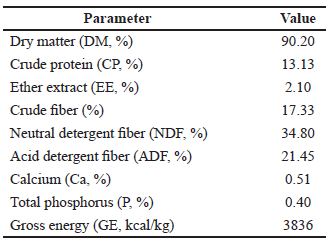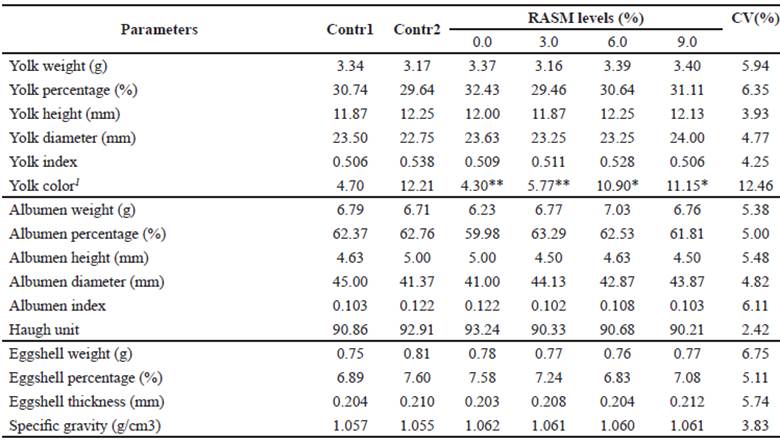Introduction
Nutrition plays an important role in quail productivity and egg quality. Sorghum can be used to replace corn (Moura et al., 2011). However, as sorghum is poor in carotenoids, it is necessary to add artificial pigments to the diet to enhance yolk color (Oliveira et al., 2008).
Residual annatto seed meal (RASM), a byproduct of bixin extraction (Santos et al., 2015), can be used in animal feed. Annatto seeds are externally covered by reddish pigments, primarily, carotenoids such as bixin and norbixin (Mantovani et al., 2013). Bixin is used as a coloring substance in the food, pharmaceutical, and cosmetic industries (Raddatz-Mota, 2017). The annatto grain residue has considerable nutritional value due to its high content of protein, fiber, and minerals (Queiroz et al., 2011). According to Rêgo et al. (2010), bixin extraction generates 98% of the byproduct, of which 97% is not reused. Brazil is one of the major producers and exporters of this coloring residue. According to several researchers, RASM could be included in feed for cattle (Rêgo et al., 2010), broilers (Souza et al., 2015), and laying hens (Garcia et al., 2014). The growing demand for natural colors makes RASM a profitable and viable alternative in agriculture because, in addition to economic considerations, the annatto plant has the advantage of adaptability and reasonable tolerance to drought (Ribeiro et al., 2013).
Therefore, this study was carried out to determine the nutritional value of RASM, as well as its effect on productivity and egg quality of laying quails.
Materials and Methods
Ethical considerations
The experimental protocol was approved by the Ethics Committee on Animal Use (protocol number 01/13; May 7, 2013) of Universidade de Rio Verde, Brazil.
Digestibility experiment
A total of 160 laying Japanese quails were used in this experiment. All individuals were 50 day-old females and were maintained in metallic cages (33 × 25 × 20 cm) for 10 days, with 5 days for adaptation to the diets and 5 days for excreta collection.
A completely randomized design was used, with two treatments, 10 replicates, and eight birds per experimental unit. Treatments consisted of a reference diet based on ground corn and soybean meal, and a test diet containing 75% of the reference diet and 25% RASM, w/w (Table 1). Diets were formulated in accordance with quail requirements (Rostagno et al., 2011) and, together with water, were provided ad libitum throughout the experimental period.
Table 1
Nutritional composition of the reference diet.
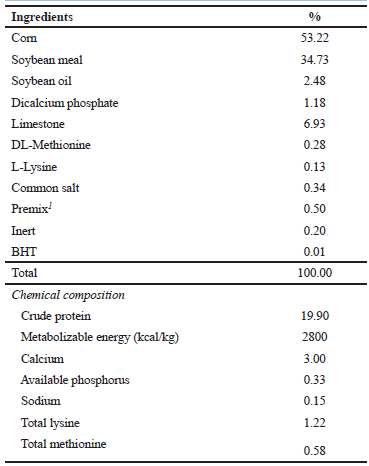
1Each kg feed contains: vit A: 9,000 IU; vit D3: 2,500 IU; vit E: 10 IU; vit K3: 1.8 mg; vit B12: 12 mcg; niacin: 25 mg; pantothenic acid: 10 mg; folic acid: 0.4 mg; thiamin: 1.5 mg; choline: 0.5 g; riboflavin: 5 mg; pyridoxine: 1.5 mg; biotin: 0.04 mg; Cu: 10 mg; Fe: 40 mg; I: 1 mg; Mn: 0.075 g; Se: 0.3 mg; Zn: 50 mg; methionine: 0.1 g; chloro-hydroxyquinoline: 30 mg; antioxidant: 2.5 mg.
The total excreta collection method was used, with ferric oxide (1.0%) as a fecal marker to indicate the start and end of the collection period. Excreta were collected twice a day (at 8 and 16 h), packed, weighed, and stored in a freezer (-18 °C) for later analysis. At the end of the experiment, these were defrosted, homogenized, and weighed again. Subsequently, they were dried in a forced-air oven at 55 °C for 72 h, ground, and packed again.
Excreta, diets, and RASM samples were analyzed for dry matter (DM), crude protein (CP), ether extract (EE), calcium (Ca), phosphorus (P), crude fiber (CF), and gross energy (GE), based on the methods of Silva and Queiroz (2002). Apparent nutrient digestibility and apparent metabolizable energy (AME) were determined as follows:
where DCDM stands for digestibility coefficient of dry matter, DM for dry matter, AME for apparent metabolizable energy, and GE is gross energy. The Matterson et al. (1965) formula was used to obtain the digestible nutrients from RASM:
where MEF stands for metabolizable energy of the feed, METD for metabolizable energy of the test diet, and MERD for metabolizable energy of the reference diet.
Performance experiment
A total of 192 laying female Japanese quails were used in this experiment. All individuals were 50-days old, and were kept for 84 days divided into 3 cycles of 28 days each. The experimental design was completely randomized, with six treatments, four replicates, and eight birds per experimental unit. The treatments included a control diet based on corn (Contr 1), a basal diet based on sorghum (BD) containing an artificial pigment, canthaxanthin 10% (Contr 2), BD with no RASM or artificial pigment, BD with 3% RASM, BD with 6% RASM, and BD with 9% RASM. The experimental diets were formulated according to the nutritional requirements for quails, as recommended by Rostagno et al. (2011) (Table 2). Photoperiod in the birdhouse was set at17:7 h light: day schedule. Water and diets were provided ad libitum.
Feed intake, egg production, egg mass, feed conversion per egg mass and per dozen eggs, egg weight, egg pH, specific gravity, yolk color, Haugh unit, yolk, albumen, and eggshell absolute and relative weight, yolk and albumen diameter and height, and eggshell thickness were assessed.
The egg production period was divided into three periods of 28 days each. At the end of each period, the feed left in each feeder was collected to calculate feed intake. Egg collection and mortality were recorded twice a day. Percent egg production was calculated by dividing the total amount of eggs per cage by the number of quails, correcting for mortality. The eggs of the last three days of each period were weighed individually to obtain the average weight of the eggs. Egg mass was the product of total egg production by the average weight of eggs per pen. Feed conversion per egg mass was the ratio of feed intake to egg mass, and feed conversion per dozen eggs was the ratio of feed intake to egg production, multiplied by 12.
Table 2
Nutritional composition of the experimental diets.
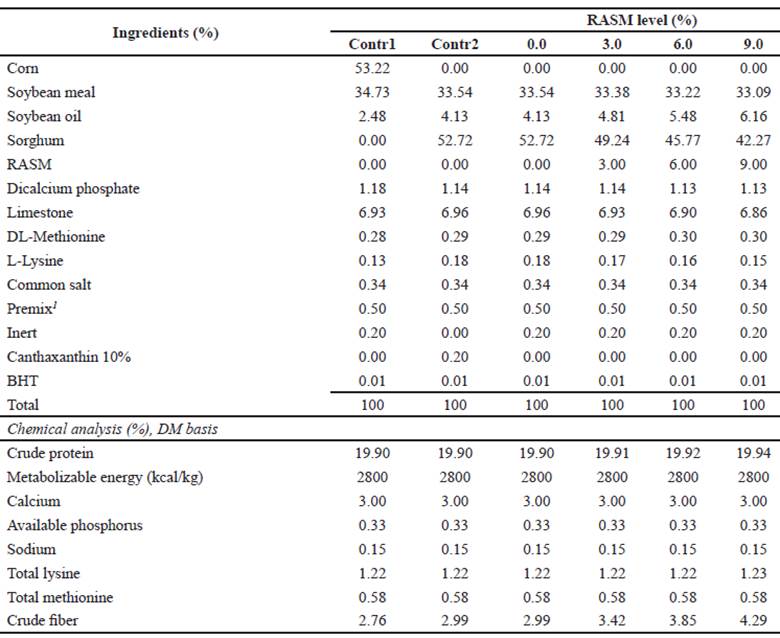
[i] 1 Each kg of feed contains: vit A: 9,000 IU; vit D3: 2,500 IU; vit E: 10 IU; vit K3: 1.8 mg; vit B12: 12 mcg; niacin: 25 mg; pantothenic acid: 10 mg; folic acid: 0.4 mg; thiamin: 1.5 mg; choline: 0.5 g; riboflavin: 5 mg; pyridoxine: 1.5 mg; biotin: 0.04 mg; Cu: 10 mg; Fe: 40 mg; I: 1 mg; Mn: 0.075 g; Se: 0.3 mg; Zn: 50 mg; methionine: 0.1 g; chloro hydroxyquinoline: 30 mg; antioxidant: 2.5 mg.
RASM -residual annatto seed meal; Contr1 -control diet based on corn; Contr2 -control diet based on sorghum.
Yolk and thick albumen diameter and height were measured with a digital caliper and a micrometer, respectively. Average eggshell thickness was determined at three locations (at both poles and in the middle) using a digital caliper with 0.001 mm precision (Digimess, São Paulo, SP, Brazil). Haugh units were obtained using the formula: HU = 100 × log (H − 1,7 × W0.37 + 7.6), where H is albumen height (mm), and W is egg weight (g). A colorimetric fan was used for yolk color evaluation, using five eggs from each replicate.
Statistical analysis
Productive performance and egg quality of the sorghum-based diets containing RASM were analyzed with ANOVA in ActionStat (Equipe Estatcamp, 2014). When the F test results were significant, the data were subjected to polynomial regression at 5% probability and their means were compared to those of Contr1 and Contr2 treatments by the Dunnett test, at 5% probability.
Results
The nutrient composition of RASM is listed in Table 3.
Nutrient utilization and energy results are presented in Table 4.
Table 4
Use of nutrients and energy from residual annatto seed meal (RASM) by Japanese quails, based on dry matter data.
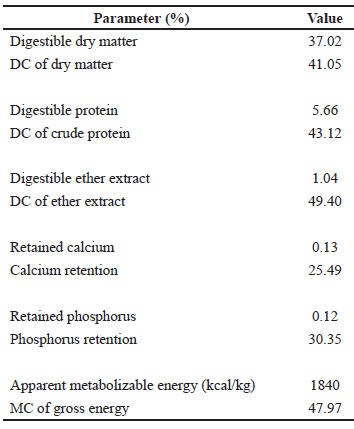
The RASM inclusion level in the diets did not influence (p>0.05) feed intake, egg weight, laying rate, egg mass, or feed conversion, and these results did not differ (p>0.05) from those obtained with diets containing canthaxanthin. However, compared with the corn-based treatment, feed conversion of birds fed diets with 0, 3, and 6% RASM was worse (Table 5).
The increasing levels of RASM inclusion in the diets did not affect (p>0.05) egg quality parameters (Table 6), except for yolk color, which increased linearly (p<0.05) in 0.86 points for each 1% RASM inclusion.
Discussion
The moisture content of RASM (9.80%) follows the recommended values for meals used for animals in Brazil, which is 12% maximum (Brasil, 2007). The DM content was similar to the 88.8% described by Tonani et al. (2000); however, our results revealed values higher than 85.80% reported by Lima Jr et al. (2014) and slightly lower than 92.43% reported by Carvalho et al. (2009).
Proteins are structural and functional components in cells; they have immunological functions, participate in hormone production, and catalyze organic reactions (De Angelis & Tirapegui, 2007). Tonani et al. (2000) reported similar values for CP in RASM (13.5%); however, Kumar et al. (2007) reported a higher value (14.40%). Valério et al. (2015) found a value lower (11.50%) than the one obtained in the present study.
Kumar et al. (2007) and Valério et al. (2015) found EE values close to those obtained in this study (2.00% and 2.23%, respectively). Regarding GE, Valério et al. (2015) obtained a lower value (2,345 kcal/kg). These differences may be related to the pigment extraction method and seed processing by the cosmetic industries and consequent RASM production.
Fiber is very important for gut function and fecal moisture maintenance, and RASM is relatively high in fiber (17.33%), whichis close to the 15 and 16% reported by Tonani et al. (2000) and Bressani (1983), respectively.
RASM is a rich source of minerals. Its Ca and P content were higher than those of other feeds described by Rostagno et al. (2011), such as corn (0.03% Ca and 0.25% P) and sorghum (0.03% Ca and 0.26% P); however, the Ca and P content were different from 0.04% Ca and 0.70% P obtained by Kumar et al. (2007).
It is possible that the low digestibility coefficients of DM, CP and EE, mineral retention, and use of gross energy found in this study were caused by the high crude fiber in RASM (17.33%), which has the ability to accelerate gastric emptying, reduce enzymatic activity and nutrient uptake, and decrease nutrient absorption because of its interactions with the intestinal mucosa (Müller et al., 2018).
None of the nutrients showed a high digestibility coefficient. However, the values in this study were close to those obtained with other byproducts used in bird diets, such as wheat bran and defatted rice bran, which showed very similar energy metabolization coefficients and metabolizable energy values (48.82 and 50.72% and 1,911 and 1,897 kcal/kg, respectively; Rostagno et al., 2011). Although RASM has high gross energy value, it becomes evident that this energy has little advantage for quails, as there is an inverse relationship between fiber content and nutrient digestibility (Pagnussatt et al., 2011), and consequently, energy utilization.
The low protein utilization, and Ca and P retention observed could also have been caused by fiber quality, because crude fiber content in RASM is similar to the values reported for wheat bran and defatted rice bran; however, the digestible protein content in the latter feedstuffs is higher (12.03 and 11.88%, respectively) according to Rostagno et al. (2011). Acid detergent fiber (ADF) is the indigestible fraction of crude fiber, which may influence nutrient digestibility (Gomes, 1996). The ADF value in RASM (21.45%) was higher than that in wheat and rice bran (13.64 and 15.80%, respectively; Rostagno et al., 2011). The different processing methods of the feedstuffs or the existing differences among the tested animal species result in different levels of nutrient use from a feed.
The amino acid availability in sorghum, such as that of lysine and methionine, is lower compared to corn (Moughan et al., 2014) because endosperm protein is more adherent to the starch granules in sorghum than in corn (Sedghi et al., 2013), which may have contributed to the poor feed conversion of diets containing sorghum and RASM at 3 and 6%, relative to the treatment with corn.
In the treatment containing sorghum + 9% RASM, feed conversion values were similar to those obtained for corn-based diets. Sorghum contains tannins (low level), phytate, kafirin, and polyphenols that may have anti-nutritional effects (McCuistion et al., 2018), causing lower digestibility and nitrogen retention rates (Pasquali et al., 2017) relative to corn-based diets. However, these effects may have been mitigated by a lower ratio of sorghum and higher oil level relative to corn-based diets. Oil improves nutrient digestibility and increases lipase activity (Polycarpo et al., 2014). According to Kil and Stein (2011), oil inclusion in pig diets improves digestibility of most amino acids, which is attributed to the ability of oil to increase gastric emptying time and to reduce passage rate, which, in turn, increases the time for protein digestion and amino acid absorption.
RASM inclusion did not have an effect on feed intake probably due to the diets being iso-nutritive, ensuring the same nutritional and energetic density in all treatments. Similarly, Silva et al. (2006), when assessing RASM in diets for laying hens, did not observe differences in productive performance and recommended 12% RASM inclusion in the diet.
RASM’s carotenoids intensified yolk color through xanthophyll -a group of carotenoid pigments- deposition. These results depend on the amount of pigment used in the diet, the deposition rate in the tissues, and the ability of birds to digest, absorb, and metabolize the pigment (Klassing, 1998). Free carotenoids are absorbed with fatty acids, dissolved in the micelles (Abdel-Aal et al., 2013), and transported by lipoproteins in the blood. Carotenoid transport depends on several factors, such as peripheral tissue demand, chemical properties of carotenoids, affinity of carotenoids for receptors and transporters, and ability of lipid vesicles to cross membranes in the liver and egg. Livers and eggs act as storage tissues (Moreno et al., 2016).
Absence (0%) or 3% RASM inclusion in the sorghum-based diets promoted a yolk color similar to that of corn-based diets; however, 6 and 9% RASM inclusion resulted in a yolk color comparable to that of diets containing canthaxanthin, allowing us to infer that RASM could be used to enhance yolk pigmentation in quails.
Similar results were reported by Braz et al. (2007) and Garcia et al. (2014) when researching RASM levels from 0.5 to 2.5% for laying hens; showing no differences in egg quality, with the exception of yolk color, which increased with RASM use. Garcia et al. (2010) and Laganá et al. (2011) studied the inclusion of annatto seeds in diets of laying hens and detected an improvement in yolk color.
The RASM used contained 37.02% digestible dry matter, 5.66% digestible protein, 1.04% digestible ether extract, 0.13% retained calcium, 0.12% retained phosphorus, and 1,840kcal/kg apparent metabolizable energy for quails. Thus, RASM may be included at 9% concentration in sorghum-based diets of laying quails, resulting in improved yolk color and no negative effects on bird productivity or egg quality.



